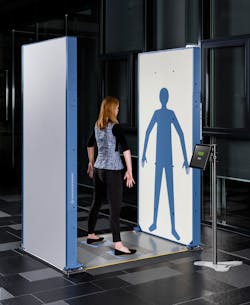Security by Design – New Security Technology and the Future of Airport Security Checkpoint Design
While the last major new US airport was completed and opened its doors in Denver over 24 years ago, in the US and around the world, hundreds of billions of dollars are being invested in airport construction, modernization and expansion projects aimed at increasing capacity to accommodate rapidly growing numbers of travelers. According to the Federal Aviation Administration’s (FAA) Aerospace Forecast 2018-2038, domestic air travel is expected to increase over 40 percent in the next twenty years while international travelers, to and from the US, will more than double. Without new, higher performing, and more efficient aviation security technologies, passenger screening processes and checkpoint layout and design will remain restricted to the current status quo. Given the evolving threat stream facing the aviation sector, coupled with the increased passenger volumes, the current state of play is not sustainable.
New,innovative technology presents a viable solution for addressing these challenges.
Post 9/11, airport security screening has evolved, in response to threats and attempted terrorist attacks. This has led to the introduction of a number of screening solutions, like standard metal detectors, and major U.S. airports now employ full-body millimeter wave imaging technology, or Advanced Imaging Technology (AIT), as the primary screening technique to detect and identify potential person borne threats. Over the years, as threat detection systems and the number of TSA personnel required to operate them has expanded, so has the checkpoint space that airports have had to relinquish to TSA to accommodate the screening infrastructure. In addition to requiring a substantial amount of space for x-ray scanners, large AIT systems, metal detectors and extra space for service and maintenance, because overall checkpoint space is consumed by screening technology, TSA screening layouts require additional space to provide access for mobility challenged travelers and for wheel-chair passage. Neither the current design and layout, nor the current screening technologies, can support the highly efficient checkpoint security operations required to screening of growing volumes of travelers. For years, TSA’s Checkpoint Design Guide has served as the blueprint and continues to challenge even the most creative architects and engineers to do anything other than replicate similar checkpoint designs at airports across the country.
Investment in New Technologies Supports New Checkpoint Designs
Over the past several years, as passenger wait-times have swelled, airports, air carriers and travelers have been saddled with long wait-times and the costs associated with missed flights and disrupted operations. Current operations are strained and without space to add additional lanes and increase security screening capacity, options to remedy to situation are further limited by the space required for, and performance challenges of, currently fielded security technology. High false alarm rates, and the time-consuming alarm resolution procedures and re-screening process, can bring security checkpoints and queues to a halt. To resolve alarms, TSA’s workforce and passengers must endure invasive pat-down procedures that further reduce checkpoint throughput. While TSA recently announced its procurement of higher performance scanners to screen passengers’ carry-on belongings that may make one part of security easier and faster, the screening of people for person-borne threats will continue to be a chokepoint, due to current AIT technology’s performance challenges and associated layout and space requirements as dictated by the Design Guide. As new high performance AIT technology becomes available to US airports that supports both higher detection, better throughput, and takes up less space, airports can finally transform their security checkpoints with design options and efficiencies never before possible.
Designed for Speed and throughput
How are new AIT’s different and how do they help airports extend their expansion and modernization investments to include TSA’s checkpoints and improved security screening for travelers?
Fully electronic, new enhanced AIT (eAIT) technology has no moving parts, Instead, the system consists of two flat panels that provide an open scanner in place of the confining chamber of legacy technology into which passengers must enter to be screened. Each flat panel of the new eAIT is integrated with over three thousand transmitter and three thousand receivers. Each transmitter is sequenced one at a time as the three thousand coherent receivers pull signals from the noise and bounced off the screened person’s skin to yield a 3-D map of all reflection points and reveal any anomalies. When the Automatic Threat Resolution (ATR) process detects an anomaly, it is then mapped to an avatar and presented to the operator for resolution.
Speed. The throughput of a millimeter wave security scanner is not just a function of scan time, but must also include the processing time for its ATR process, false alarm rate, and resulting secondary alarm resolution procedures. While currently deployed AIT systems can complete the scan process in approximately 6-8 seconds, promising newer technology, such as the new eAIT, are demonstrating up to a 3x improvement in scan time while also significantly reducing false alarms.
False Alarm Reduction. A lower false alarm rate achieved by the eAIT is enabled by, not only a more advanced scanning technology, but also by the speed of the scan. The scan time of a passenger using an eAIT is reduced from approximately 1.5 seconds to 64 milliseconds, more than 5 times faster than the blink of an eye. As a result, while both may seem fast, errors can be caused by passengers’ movement during the scan process of legacy AIT systems while the millisecond scan time of eAIT systems, virtually eliminates such errors.
High volume screening by design. When alarms do occur, alarm resolution or secondary screening protocols must be followed to resolve the detected anomaly alarm. During these alarm resolution procedures, screening halts and passengers have to wait to be screened. Current AIT’s have a single screen for the operator see the ATR results, presented on an avatar, and to guide the location of the anomaly to resolve the alarm. Newer eAIT technology, however, utilizes multiple image resolution stations that can be used to resolve passengers’ alarms and allow for continuous screening of other passengers. Utilizing up to four resolution stations, as outlined in the figure below, allows for significantly higher lane throughput, theoretically to 900 passengers per hour, depending on other operational factors.
The flat panel design and architecture of the new eAIT supports new checkpoint layouts and designs that allow precious checkpoint space to be used more rationally and in new configurations. Just as important, the panels of the eAIT slide inward to provide maintenance access to it or surrounding security equipment. This means that security equipment can be installed close to each other further conserving space and reclaiming the valuable checkpoint real estate lost today to provide extra space for maintenance access. eAIT scanners can be deployed side-by-side and even directly against walls. Never before has new technology helped airports consume less space and provide radically different design options. The eAIT scanner has been designed with American Disabilities Act (ADA) compliance in mind. Its open design is wide enough to accommodate wheelchairs, eliminating the need for separate wheelchair access gates. Further space reduction can be achieved by relocating ADA compliant walk-thru metal detectors in a cascading configuration with eAITs so both detection technologies to be used together.
Reliable Performance and Minimized Maintenance
Intelligent operations. To ensure stable operations and system availability, eAITs were developed with predictive diagnostic software to indicate when service is required. The eAIT tells operators when it needs to be serviced to minimize down time and resources required for maintenance. With no moving parts, maintenance and service requirements of new eAIT systems are minimized. Its solid-state design supports calibration and setup at the factory instead of in the field during field installation. Other than a six-month preventative maintenance check, the eAIT system is virtually maintenance free. The system only requires a few hours to assemble and can go to work within three minutes of powering up the system.
The advantages of the open design go beyond the accommodation of the mobility challenged. The open design also provides an unobstructed view for security personnel into the awaiting security line. Further, in the case of an emergency, the open design of an eAIT scanner does not serve as a chokepoint for the public and first responders but rather enables this area to be used for emergency egress.
Luke Olsen is the Business Development Manager of Emerging Technologies for Rhode & Schwarz. He can be reached at [email protected]
About the Author

